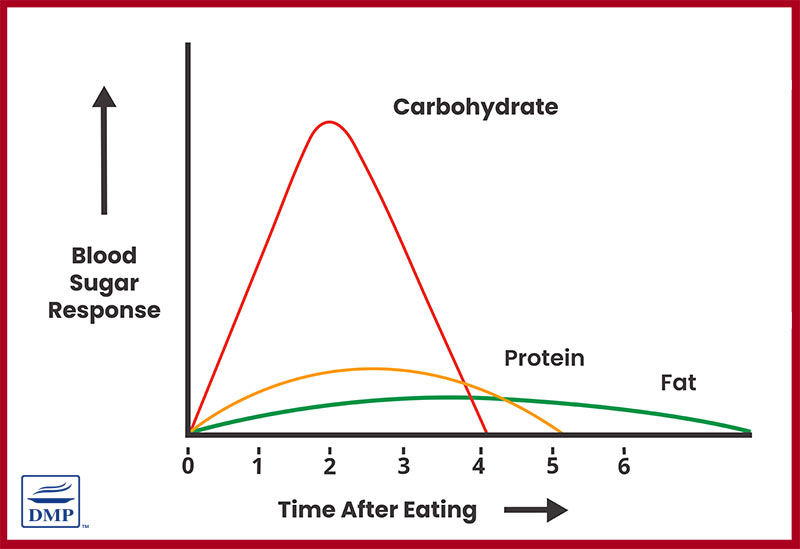While there are various “diets” you could follow, research indicates a low carbohydrate diet works very well to help control blood sugar and HbA1c levels in type 2 diabetes and prediabetes, compared to other diets.
The benefits of a diabetes low carb diet include:
- Decreased blood glucose levels
- Lower HbA1C
- Decreased cholesterol (in most people)
- Increased HDL “good” cholesterol
- Lose weight easier and achieve greater weight loss
- Reduction of diabetes medication (in many people) – always seek medical advice before changing your medications
These are all wonderful benefits for you as a person living with type 2 diabetes or prediabetes.
Let’s explore some guidelines to help you get your eating plan on track.
It’s easier than you think to eat a healthy low carb diet, and the meals are tasty, delicious and very flexible!
Quick Fact: DMP nutritionists recommend 50 to 80 grams of carbs per day, or up to a maximum of 100 grams for people with type 2 diabetes.
📌Go here to read more about how many carbs to eat.
4 Basic Diabetes Low Carb Diet Guidelines
Quit high-carb foods – that of course is one basic rule to follow!
Then, if you follow these 4 basic guidelines, you’ll find you will be heading on the right track.
1. Eat Plenty of Vegetables
Vegetables, particularly the type that grow above the ground (non-starchy vegetables) such as cauliflower, broccoli, asparagus, cucumber, cabbage, Brussels sprouts, artichoke, and so forth.
Vegetables are a central part of our low carb eating plan because research shows that we need plentiful amounts of dietary fibre, vitamins, minerals, phytochemicals, polyphenols, and compounds to help improve our health.
By focusing on eating large amounts of healthy vegetables as your predominant source of carbs, you instantly slash your carb intake and this makes a huge difference with glucose control.
2. Don’t Fear Fat
When you reduce carbohydrate in your diet, it’s natural to eat more fat.
Fat is nothing to be feared, in fact, our body requires fat to function properly.
Compared to other nutrients, especially carbs, fat does not spike blood sugar levels.

Contrary to popular thinking that a low-fat diet is best for weight loss, eating more fat can actually help you burn fat. In fact, in many ways, it does the exact opposite of what we’ve been led to believe.
While there is no need to avoid fat found in natural whole foods like meats, poultry, fish, nuts and seeds, we do encourage you to include more monounsaturated fats like olive oil, nuts, seeds and avocado – healthy fats that have been shown to help improve insulin sensitivity, reduce insulin resistance, improve glucose transport into cells, as well as providing benefits for heart health.
3. Eat Protein
Nutrient-dense protein increases satiety – keeping you full and satisfied for longer.
You can eat all types of meats, chicken, fish, and seafood.
You can select from a large range of dairy products like cheese, yoghurt, feta, and ricotta, along with eggs (and their yolks).
This gives you loads of protein options to help make your meals super tasty.
4. Avoid sugar and starchy foods
“Added” sugar-filled foods such as cakes, candy, muffins, processed foods, and most fruits. Quite simply because these foods are higher in carbohydrates so they tend to raise blood sugar.
Avoid starchy foods – bread, pasta, rice, noodles, flour-based foods and potatoes, including sweet potatoes.
Relax…there are plenty of lower carb options, you just need to learn what they are!
Eating a lower carb diet is actually very flexible and thoroughly enjoyable.
How Does This Low Carb Diet Thing Stack Up?
Eating a lower carb diet is a little different to the typical high-carb diet you may be accustomed to eating (full of breads, pasta, rice and potatoes).
While there are various types of low carb diets, for instance, keto or Atkins, which are very low carbohydrate ketogenic diets that restrict carbs to under 20 grams or 50 grams per day, research indicates that anything under 130 grams per day can provide benefits.
In fact, if you lower your carbs by any amount, you’re bound to see better results with your blood sugar and HbA1c!
We’ve found that a sweet spot for carb intake seems to be somewhere between 50-80 grams per day, or up to a maximum of 100 grams per day.
Based on a 1600 calorie/ day menu, a lower carb diet can stack up to roughly:
- 10-20% Carbs: 40-80 g/d
- 15-30% Protein: 65-120 g/d
- 40-75% Fat: 70-133 g/d
However, if you were to increase your carbs to 25% of daily calories, which is often a good place to start, your intake would look like this, based on a 1600 calorie/ day menu:
- 25% Carbs: 100 g/d
- 15-30% Protein: 65-120 g/d
- 45-60% Fat: 80-106 g/d
Each day of food always looks slightly different and it can get fairly boring trying to calculate everything exactly. Instead, if you follow the above 4 general rules and refer to our recommended food list, you’ll find that your daily intake will come somewhere within these guidelines.
📌Click here for a complete diabetes food list
KEY POINTS
Eat plenty of fresh non-starchy vegetables
Don’t fear fat from natural food sources, include more monounsaturated fats like avocado, olives, olive oil, nuts and seeds
Eat a variety of protein sources
Avoid sugar-filled foods (processed foods) and starchy foods like bread, pasta, rice, and potatoes
Aim for between 50-80 grams of carbohydrates per day, or up to a maximum of 100 grams per day.
Want more help and support?
Try our weekly meal plans and nutrition support service.
We’d love to see you as one of our members!

